
July 2003
Background | Oil | Natural Gas | Coal | Electricity | Environment | Profile | Links
Brazil
Brazil is the largest country in South America and
has experienced rapidly expanding oil, natural gas, and electricity
markets in recent years. The country is in the process of recovering
from an energy crisis in 2001.
Note: information contained in this report is the best available as of July 2003 and is subject to change.
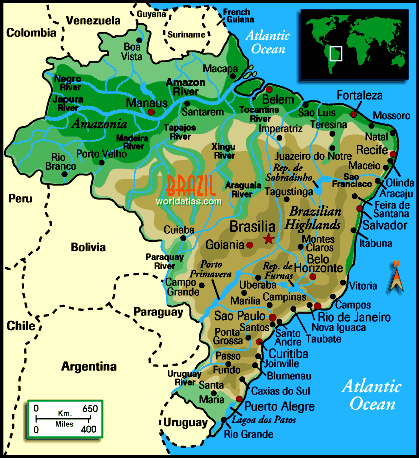 BACKGROUND
BACKGROUND
In October 2002, Luiz Inacio Lula da Silva was elected president,
replacing Fernando Henrique Cardoso. The election marked a return
of the left to power, 38 years after a military coup overthrew President
Joao Goulart of the Brazilian Labor Party (PTB). President da Silva
was elected with the support of an alliance composed of his own
leftist Workers' Party, the PT, the center right Liberal Party,
(PL), the National Mobilization Party (PMN), the Popular Socialist
Party (PPS, formerly the PCB), and the Communist Party of Brazil
(PCdoB). During his election campaign, Mr. da Silva promised to
lead campaigns against hunger (Zero Hunger Initiative) and for increased
social spending in the areas of health, education and public security.
The new government continues to work on reforming the pension system
and the tax code after submitting two bills to the Congress in late
spring.
President da Silva's election initially resulted in a weakening of the Brazilian currency, as investors feared the impact of the new government's social agenda. However, after the new administration indicated that reforms will take a long time, and introduced fiscal austerity policies, the real climbed in value. Despite a weak international economy and the lingering effects of the 2001 energy crisis, the Brazilian economy has remained resilient, managing to post 1.5% real gross domestic product (GDP) expansion in 2002.
In June 2003, Brazil signed two energy cooperation agreements with the United States. As part of the agreements, the two countries will begin discussion on collaborating on hydrogen and fuel cells, making Brazil the first Latin American country to join the Bush administration's proposed International Partnership for the Hydrogen Economy. Brazil and the United Stated also signed a bilateral agreement on electricity deregulation, offshore safety, and the development of clean energy technologies, as well as began negotiations for Brazil to become a charter member of the Carbon Sequestration Leadership Forum.
OIL
Brazil contains the second largest oil reserves in South America
(after Venezuela), at 8.3 billion barrels. The country continues
to strive for self-sufficiency in oil production by 2006 and has
made positive steps towards reaching this goal. In May 2003, Petrobrás
announced that it plans to invest $34 billion over the next four
years, mainly in exploration. The state-owned oil company also expects
its average domestic oil production (not including production from
other companies) to reach 1.82 million barrels per day (bbl/d) by
2005. 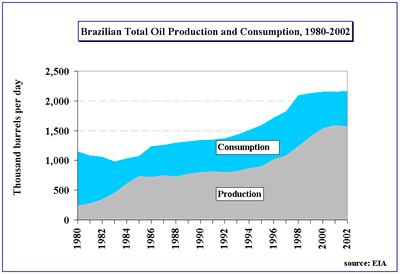 The drivers behind the increase are a number of new fields coming
onstream and improved production performance, according to Petrobrás.
However, new government regulations (see below) have delayed the
construction of new floating production platforms, which resulted
in Petrobrás downgrading its initial production estimate of 1.9
milliuon bbl/d by 2005.
The drivers behind the increase are a number of new fields coming
onstream and improved production performance, according to Petrobrás.
However, new government regulations (see below) have delayed the
construction of new floating production platforms, which resulted
in Petrobrás downgrading its initial production estimate of 1.9
milliuon bbl/d by 2005.
Overall, total oil production has been rising steadily since the early 1990s, averaging nearly 1.6 bbl/d in 2002. The offshore Campos Basin, north of Rio de Janeiro, is the country's most prolific production area (see map below). Brazil's oil consumption for 2002 was estimated at almost 2.2 million bbl/d. Brazil's oil imports come mostly from Africa and the Middle East and, to a lesser extent, from Venezuela and Argentina, according to 2000 data.
Petrobrás is seeking to expand its oil and natural gas operations outside of Brazil. In October 2002, The company acquired a majority stake in Argentina's Perez Companc, increasing its oil and natural gas reserves significantly.
Exploration and Production
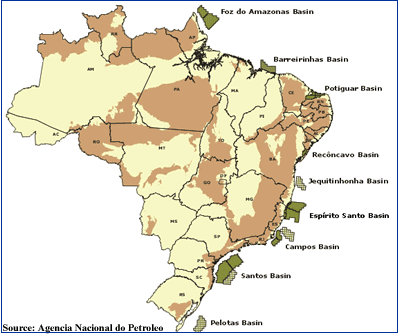 Petrobrás is the only company to have made commercially
viable discoveries in Brazil in recent years. Most of these are
located in the northern Campos Basin, along the coast of Espirito
Santo State, at block BC-60. In June 2003, Petrobrás announced that
it had made three new discoveries in the block. These finds follow
a previous discovery in May 2003 and in March 2003, at the Sergipe
offshore SEAL 100 block.
Petrobrás is the only company to have made commercially
viable discoveries in Brazil in recent years. Most of these are
located in the northern Campos Basin, along the coast of Espirito
Santo State, at block BC-60. In June 2003, Petrobrás announced that
it had made three new discoveries in the block. These finds follow
a previous discovery in May 2003 and in March 2003, at the Sergipe
offshore SEAL 100 block.
International Companies
Despite exploration efforts, Total, BP and ConocoPhillips have yet
to find an oil field in Brazil that is large enough to be commercialized.
According to these companies, recent discoveries are small and located
in deep waters, and the oil contained in the fields is extremely
viscous, requiring expensive recovery processes. In July 2003, Total
announced plans to scale back on exploration activities for the
time being and did not plan to take part in the next oil exploration
and production licensing round, set for August 2003. Consulting
firm Wood MacKenzie released a report in June 2003 stating that
the lack of recent commercial discoveries will impact Brazil's mid-to-long-term
oil production, with decline possibly starting in 2007 (Please see
graph below). Wood MacKenzie added that a change in fiscal terms,
attached to exploration and production activities, could make some
fields commercially viable. Although Brazil has large oil reserves,
increases in production will be depend on attracting investment
and on new technologies that would help lower recovery costs.
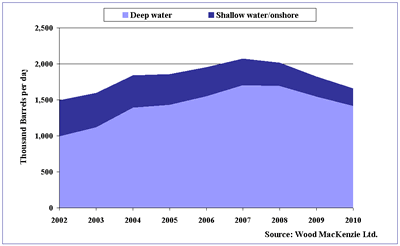 Repsol-YPF is currently the only international oil company producing
oil in Brazil. Shell is expected to begin producing 70,000 bbl/d
at the deepwater Bijupira-Salema field in the Campos Basin by mid-2003.
The company is the majority shareholder (80%) while Petrobrás holds
the rest. In May 2003, Shell also received permission to export
oil.
Repsol-YPF is currently the only international oil company producing
oil in Brazil. Shell is expected to begin producing 70,000 bbl/d
at the deepwater Bijupira-Salema field in the Campos Basin by mid-2003.
The company is the majority shareholder (80%) while Petrobrás holds
the rest. In May 2003, Shell also received permission to export
oil.
Accidents and the Environment
Over the years, poor safety and
environmental records
have tarnished Petrobrás' image. In March 2001, explosions
on the deepwater platform P-36, located at the Roncador field, caused
the world's largest platform to sink into the Atlantic Ocean. Production
at the Roncador stopped but was brought back onstream in December
2002. In October 2002, platform P-34 had to be evacuated when the platform
tilted to 32 degrees. The platform was saved but not without disrupting
production. Brazil's state environmental agency also fined the company
for running oil operations without the required environmental licenses.
Petrobrás plans to improve both its safety and environmental records.
Sector Organization
Prior to 1997, Petrobrás, which was created in 1953, monopolized
rights to explore, produce, refine, and distribute oil in Brazil.
Prices for Petrobrás oil were also fixed. In 1997, the former President
Cardoso signed the Petroleum Investment Law. The law permitted joint
ventures between foreign oil companies and Petrobrás. The law also
opened up Brazil's sedimentary basins to drilling operations by
foreign and Brazilian firms. The new law also created National Petroleum
Agency (ANP), charged with issuing tenders, granting concessions
for domestic and foreign companies, and monitoring the activities
of the sector, including establishing rights to explore for and
develop oil and natural gas in Brazil. One of the main drivers behind
opening the oil sector was to increase oil production in order to
reduce dependence on oil imports and eventually achieve self-sufficiency.
Most of Brazil's reserves were and remain located offshore in deep
water, requiring extensive capital investment to develop.
In July 1998, ANP announced that more than 92% of the nation's sedimentary basins were to be put up for bidding by other oil companies. Also in 1998, oil prices in Brazil became linked to world oil prices. In August 2000, the government sold a 28.5% stake in Petrobrás. In January 2002, the company lost its monopoly on importing oil and refined products.
New Government
After taking office, President da Silva began showing signs of reversing
some of the privatization policies of the former administration.
For instance, the government now requires companies which are awarded
oil and natural gas leases to devote a percentage of their investments
to
purchase goods and services provided by Brazilian firms
. This requirement fulfills one of President da Silva's electoral
promises to increase the role of the domestic industry in developing
the country's oil and natural gas reserves. During the presidential
campaign, Mr. da Silva stated that the oil platforms P-51 and P-52
should be built domestically in order to create economic growth.
In July 2003, Petrobrás launched a bidding round for the building of P-54 production platform. According to the new regulations, the project will require between 60% and 75% of the parts to be constructed in Brazil
Tax in Rio de Janeiro State
On June 30, 2003, the governor of Rio de Janeiro signed a bill that
imposes an 18% tax on oil production, but then suspended its implementation
in the face of strong opposition from oil companies (Shell and ChevronTexaco)
operating in the country. If the tax is eventually approved, it
will be applied at the wellhead, but not to exports, sparing foreign
companies producing oil in Brazil. Nonetheless, some analysts suggest
that the new tax would further discourage interest from foreign
companies, as they have already expressed concern about recent small
oil finds. In addition, these finds are mainly heavy crude and at
great depths, which only increases production costs.
International Cooperation
Brazil and Venezuela have held talks discussing potential oil and
natural gas partnerships between Petrobrás and Petroleos de Venezuela
(PDVSA). Activities include heavy crude oil refining, exploration,
production, as well as joint ventures in the petrochemicals and
natural gas sectors. The first project could be a partnership in
constructing a new heavy crude refinery, which Petrobrás intends
to build.
Bid Rounds
Since opening up the oil industry, ANP has held four bidding rounds.
The fifth round, planned for August 19-20, 2003, differs in several
ways from previous rounds. The government decided (as mentioned
above) to require increased inclusion of local equipment and services
related to oil operations. Second, a majority of the blocks up for
bid are small and located in shallow waters, whereas previous rounds
offered larger blocks. ANP hopes to attract smaller oil companies
to bid on these blocks. In all, 1,075 blocks will be up for bidding,
of which 262 are located onshore, 742 in shallow waters, and 71
in deep waters, according to ANP. Finally, analysts have suggested
that this round is less attractive for larger companies than previous
rounds, citing uncertainties about taxes, lack of recent commercial
discoveries, the geological challenge of oil recovery in deep waters,
and new opportunities for oil companies in the Middle East.
Previous Rounds
Foreign companies first became involved in the Brazilian oil sector
in 1997, through joint-ventures with Petrobrás. The first bidding
round that allowed foreign companies to compete against Petrobrás
occurred in 1999. The blocks for offer in the round, which were
extremely large (the average size of each area was 1,800 square
miles, equivalent to 225 blocks in the Gulf of Mexico), were sold
to 10 foreign firms, as well as to Petrobrás, which won 5 of the
12 blocks. Foreign firms, such as Agip, Unocal, Texaco, Amerada
Hess, Repsol-YPF, and ExxonMobil made successful exploration bids,
with some acting in alliance with Petrobrás. Most of the bids were
for relatively unexplored but highly coveted areas in over 6,560
feet (2,000 meters) of water off Brazil's Atlantic coast.
In June 2000, Brazil's second licensing round offered 23 blocks in nine sedimentary basins, including Campos (the Campos Basin is responsible for roughly 70% of the country's current total crude oil output), Amazonas, Camamu-Almada, Parana, Para-Maranhao, Potiguar, Reconcavo, Sergipe-Alagoas, and Santos. The second round was hailed as more successful than anticipated, with Petrobrás winning many bids in partnerships with foreign companies. The Campos and Santos Basin blocks generated the most interest, receiving as many as four bids. Only two blocks received no bids.
Brazil's third bidding round, held in June 2001, offered 53 blocks, 43 offshore, and mostly in deep and ultra-deep water areas. Although about a third of the offered blocks received no bids, the round was considered a success because of the wide range of aggressive bidders that participated. The bidding round attracted major international oil companies, such as ExxonMobil, Royal Dutch/Shell, Total, and Statoil, as well as some smaller companies that were new to the Brazilian oil sector, such as U.S.-based Ocean Energy and Germany's Wintershall. As in the previous rounds, Petrobrás was the largest benefactor, winning 13 blocks and joint venture partner in two others (with operators ExxonMobil and Total).
The fourth round offered 39 offshore and 15 onshore blocks. Eight blocks were in "frontier areas" and six were in the Campos Basin. The average block size was considerably larger than those in the third round. The auction was held in June 2002, with Petrobrás once again the largest winner. Statoil, El Paso, and several other companies increased their investments in Brazil. ( Complete round results are available from brasil.gov )
Downstream
Petrobrás plans to invest $5.5 billion by 2007 to increase domestic
refining capacity by 300,000 bbl/d, to 1.9 million bbl/d, and to
upgrade many of its refineries. One of the goals of the da Silva
administration is to increase Brazil's ability to refine heavy crude
oil, which makes up a large portion of the country's crude oil production.
In April 2003, Petrobrás revealed plans to build a 150,000-bbl/d
refinery, which would be the first one in Brazil to process heavy
crude. It remains unclear where the refinery will be built and whether
it will be built in conjunction with Venezuela's PDVSA (see above).
There are 13 crude oil refineries in Brazil, 11 of which belong to Petrobrás and comprise almost 99% of total refinery capacity.
NATURAL GAS
Brazil's natural gas consumption and production in Brazil rose steadily
throughout the 1990s, with imports beginning in 1999 as demand outstripped
supply. Natural gas production reached its highest level in 2000
at 257 billion cubic feet (Bcf), but declined in 2001 by 18% mainly
due to an economic downturn. Consumption, however, continues to
increase, reaching an estimated 339 Bcf in 2001. As of January 2003,
natural gas reserves stood at 8.1 trillion cubic feet (Tcf), the
fifth largest in South America behind Venezuela, Argentina, Bolivia,
and Peru.
Industry Organization
Natural gas exploration and production historically have been carried
out by Petrobrás. Upstream privatization has not progressed as
quickly with natural gas as it has with oil. Distribution, however,
traditionly has been handled at the state level. In accordance with
Brazil's national privatization agenda, plans are underway to privatize
parts of the country's natural gas sector. Because Brazil maintains
a highly federalized government system, many state governments are
now shouldering heavy fiscal responsibilities. In an effort to raise
necessary working capital, state governments have begun to sell
their state natural gas distribution companies. Natural gas distribution
companies in Rio de Janeiro and Sao Paulo are now in private hands.
Exploration
The Campos and Santos basins hold the largest Brazilian natural
gas fields. Other natural gas basins include Foz do Amazonas, Ceara
e Patiguar, Pernambuco e Paraíba, Sergipe/Alagoos, Espírito and
Amazonas (onshore). Offshore southeast Brazil is hydrocarbon rich
yet under explored, leaving potential for significant increases
in reserves and production. In May 2003, Petrobrás confirmed Brazil's
largest natural gas discovery to date, an estimated 2.45 Tcf, on
Block BS-400 in the Santos Basin.
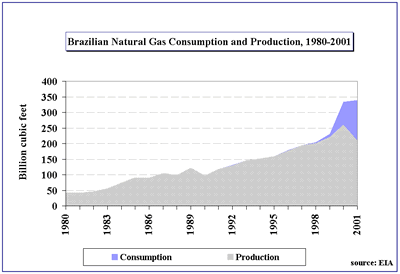 Promotion of Natural Gas
Promotion of Natural Gas
Unlike the previous administration, the da Silva government wants
hydroelectricity to remain Brazil's main source of power. In the
late-1990s, the Brazilian government under former President Cardoso
had been encouraging the use of natural gas in an attempt to reduce
the country's dependence on hydropower. In the past, hydroelectric
plants were able to keep pace with Brazil's growing demand for electricity,
but rapid electricity demand growth in the 1990s resulted in power
cuts, blackouts and rationing programs.
In 1997, the government set out to increase natural gas' share of total energy consumption from 2.5% to 12% by 2002. Along with encouraging the construction of natural gas-fired power plants, Petrobrás signed a 20-year take-or-pay commitment with Bolivia to import natural gas through the long-awaited Brazil-Bolivia (Gasbol) pipeline, which came onstream in June 1999. At the original signing of the contract, the supply volume was tied to Brazil building 16 natural-gas-fired power plants. Out of the 16 plants, Petrobrás has pulled out of six planned projects and is contemplating its role in two others. On a positive note, EdF announced in July 2003 that it plans to restart construction of the $400 million Paracambi thermoelectric power plant. EdF also plans to begin operation later this year of its 720MW Norte Fluminense thermoelectric plant.
Natural Gas Consumption
Economic developments hindered the Cardoso administration's efforts
to enlarge Brazil's market for natural gas. The devaluation of
the real in January 1999, for example, made natural gas imports
from Bolivia more expensive, as power producers had to pay for natural
gas in dollars. In addition, a severe recession deterred banks from
making loans to power developers, who were expected to absorb nearly
half of the Bolivian imports. All of these effectively disrupted
the construction of natural gas-fired power plants.
In 2001, a shortage of hydroelectricity due to a drought led the Cardoso administration to launch the Priority Thermal Power Program . The program envisaged development of 55 new natural gas-fired plants over eight years with a combined capacity of 23,000 MW. However, the plan was discontinued when rains returned along with the availability of cheap hydroelectricity. A majority of the new plants were subsequently put on hold indefinitely. In July 2002, metal manufacturers, such as Canadian Alcan, U.S. Alcoa and BHP Billiton in conjunction with power producers Tractebel, increased their commitment to hydroelectricity to support expanding their output. The Brazilian energy regulator Aneel awarded the companies concessions to build and operate eight new hydro plants. The companies indicated that they could not wait any longer for natural gas to meet their energy requirements.
New Developments: Bolivian Imports
Since signing an agreement with Bolivian state natural gas exporter
YPFB in 1997, Brazil has taken only a fraction of the natural gas,
to which it had agreed. Government delegations from Bolivia and
Brazil have met repeatedly over the last six months in attempt to
renegotiate the contract. Brazil wants to import less and pay less
for natural gas from Bolivia, suggesting a more flexible agreement.
Bolivia indicated after a meeting held in May 2003 that it would
not change the contract unless Brazil would guarantee that exports
would increase in the future.
In response, the Brazilian government revealed in June 2003 its new Natural Gas Expansion Project. The objective of the plan is to expand the country's natural gas pipeline network (see pipelines below), bringing natural gas to residential, industrial, and thermal power plants, particularly to southeastern and northeastern regions of the country where no pipelines currently exist, and which now rely on fuel oil. One of the drivers of the project is Brazil's commitment to expanding the domestic natural gas market as part of its ongoing negotiations with Bolivia.
Pipelines
Brazil has two existing international pipeline connections, with
several more under construction. The first pipeline to connect Brazil
to foreign natural gas sources was the Bolivia-to-Brazil pipeline
(Gasbol), tapping Bolivia's Rio Grande sources. The completed
covers almost 2,000 miles, and came onstream in June 1999, with
service to Sao Paulo and a terminus in Porto Alegre. The pipeline
continues to operate well below its 1.05 billion cubic feet per
day capacity, due to the high price of dollar-denominated Bolivian
natural gas and the minimal development of natural gas-fired generating
capacity in Brazil. As a result, the Brazilian government has suspended
plans to expand the Brazil-Bolivia pipeline.
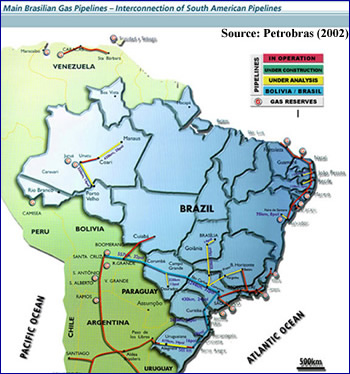 In 2002, BG signed nine-year agreement with Petrobrás, guaranteeing
access to 22.8 million cubic feet per day from the pipeline from
January 1, 2003 to December 31, 2011. Enron and El Paso Energy announced
in February 2003 that they plan to sell their stakes in the pipeline
as the expected revenue from the project has yet to materialize.
In 2002, BG signed nine-year agreement with Petrobrás, guaranteeing
access to 22.8 million cubic feet per day from the pipeline from
January 1, 2003 to December 31, 2011. Enron and El Paso Energy announced
in February 2003 that they plan to sell their stakes in the pipeline
as the expected revenue from the project has yet to materialize.
Brazil's second operational international natural gas pipeline links Paraná, Argentina, to Uruguaiana, Brazil. The pipeline, Transportadora de Gas del Mercosur, is 270 miles long. The pipeline supplies natural gas to a $350-million, 600-megawatt (MW) AES power plant in Uruguaiana. Service began in July 2000. The Argentinean government is currently promoting a 384-mile pipeline extension, the Transportadora Sulbrasileira de Gas (TSB), which would connect Uruguaiana to Porte Alegre . However, the project most likely will not proceed until there is a decision on constructing two new natural gas-fired power plants in Porto Alegre.
New Pipeline Developments
Petrobrás recently released a statement that it is conducting a
feasibility study on a 745-mile pipeline that would link Brazil's
southeast and northeast networks, allowing it to transport natural
gas from neighboring Bolivia and from Petrobrás' fields in the Santos
Basin to the northeast.
Petrobrás also is negotiating with the states of Amazonas and Rondonia to build a 342-mile Urucu to Porto Velho pipeline. The pipeline is expected to supply 80.5 million cubic feet per day, mainly to power a 404 MW thermoelectric plant owned by El Paso and CS Participacoes. Environmental licensing problems have delayed the construction of the pipeline. In the same region, Petrobrás is proceeding with plans to build a 261-mile Coari to Manaus pipeline to be able to supply natural gas from the Urucu field to regional industry.
In January 2003, Argentinean natural gas began to flow to Montevideo, Uruguay, through the Gasoducto Cruz del Sur (GCDS, Southern Cross pipeline). The pipeline is significant because the GCDS project includes a concession covering a possible extension from Uruguay to Porto Alegre in southern Brazil. Partners in the project are British Gas (40%), Pan American Energy (30%), Uruguayan state company ANCAP (20%) and Wintershall (10%). ( For more details on natural gas distributors in Brazil ).
Liquefied Natural Gas (LNG)
In January 2003, Petrobrás announced the development of a plan
to bring stranded natural gas reserves in the Amazon to the market.
The Green LNG project would pipe natural gas from the Jurua,
Uruco, and Polo Arara fields to a floating liquefaction plant on
the Amazon River near the existing Solimoes refinery. At the refinery,
the natural gas would be liquefied and loaded onto a specially designed
LNG transport vessel, then shipped to a smaller 1.5-million-ton-per-year
capacity regasification terminal located in Suapeto. The vessel
would have a capacity of 3.5 million cubic feet in order to be able
to navigate the Amazon River. According to Petrobrás, the next steps
of the project include a more rigorous feasibility study.
COAL
Brazil's recoverable coal reserves are estimated at approximately
13.1 billion short tons of lignite and sub-bituminous coal, the
largest coal reserves in Latin America. Much of Brazil's coal is
characterized by high ash and sulfur contents, as well as low caloric
values. Overall, Brazil's coal production in 2001 was approximately
4.53 million short tons (Mmst), while consumption was an estimated
20.8 Mmst, with net imports of 16.3 Mmst.
Coal is used predominantly for Brazil's domestic steel industry, with a small portion burned to generate electricity. A 1996 study by the International Energy Agency (IEA) concluded that Brazil will continue to be one of the world's major coal importers during the next 10 to 15 years, with imports possibly doubling by 2010. The country's steel industry is expected to remain the largest domestic coal consumer for the foreseeable future. Brazil plans to increase its use of steam coal (both domestic and imported) for electric power generation.
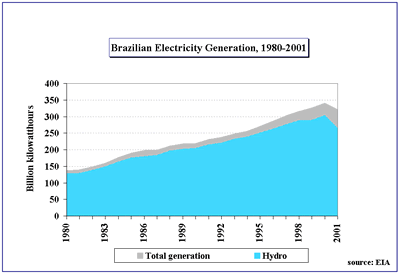 ELECTRICITY
ELECTRICITY
Brazil has installed electric capacity of 73.4 million kilowatts,
85% of which is hydropower (as of January 1, 2001). Of the 321.2
billion kilowatthours (bkwh) generated in Brazil in 2001, 83% was
from hydropower (down from 91% in 1999). Brazil ranks consistently
as one the world's top hydropower producers. Together with Paraguay,
Brazil maintains the world's largest operational hydroelectric complex,
the Itaipu facility on the Paraná River, with a capacity of 12,600
megawatts (MW). Brazil's remaining electricity generation capacity
comes from coal and an increasing amount from natural gas. Brazil's
small northern and larger southern electrical grids were joined
in January 1999 into one grid that serves 98% of the country. Brazil's
domestic supply is augmented by imports from neighboring Argentina.
Electricity Shortage
In 2001, Brazil faced a critical electricity shortage. The shortage
was a result of insufficient rainfall, as well as under investment
in the industry. Several years of below-average rainfall left reservoirs
70% depleted. During the 1990s, energy demand, on account of a growing
economy and a rising standard of living, had been consistently outstripping
increments ingeneration capacity. In 2000, consumption was about
58% higher than it was in 1990, while installed generation capacity
grew about 32% during the same period. Analysts had long predicted
that this demand growth, if not supported by capacity growth, had
the potential to lead to shortages.
The government implemented an energy-rationing program in June 2001, which prevented rolling blackouts by requiring customers to reduce consumption by 20%. Restrictions were most severe in the heavily populated southeast and central-west regions, and northeastern states had three mandatory holidays declared in the autumn of 2001 in order to reduce demand. Restrictions ending on March 1, 2002.
New Developments
Once the government lifted the rationing program, the country found
itself facing a power glut. This pushed many electricity companies
deep into debt, such as Cemar, Eletropaulo Metropolitana, Cesp,
Cemig and AES. The power glut has reduced incentives for companies
to begin construction of thermoelectric power plants. In July 2003,
the Energy and Mines Minister Dilma Roussef warned that country
could face another power crisis by 2007, particularly if the economy
begins to rebound. A report from the Brazilian Basic Infrastructure
and Industry Association reported that the country would need to
invest around $4.8 billion annually through 2020 to sustain moderate
growth and avoid another crisis.
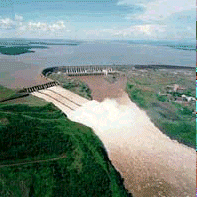 In July 2003, Brazilian Energy Minister Dilma Rousseff revealed
a new model for the electricity sector, with the goals of ensuring
reliable supply, stabilizing prices for consumers and attracting
long-term investment to the sector. One of the proposed reforms
included pooling cheaper hydroelectricity with more expensive thermoelectric
plants (natural gas). By pooling the various sources, the ministry
hopes to reduce the electricity tariffs and to ensure power is purchased
from the newly constructed thermal plants, which have yet fully
amortized. The Brazilian government plans to implement the program
by January 2004.
In July 2003, Brazilian Energy Minister Dilma Rousseff revealed
a new model for the electricity sector, with the goals of ensuring
reliable supply, stabilizing prices for consumers and attracting
long-term investment to the sector. One of the proposed reforms
included pooling cheaper hydroelectricity with more expensive thermoelectric
plants (natural gas). By pooling the various sources, the ministry
hopes to reduce the electricity tariffs and to ensure power is purchased
from the newly constructed thermal plants, which have yet fully
amortized. The Brazilian government plans to implement the program
by January 2004.
As a first step in ensuring a more reliable supply, the government has put out tenders (July 2003) for the construction of a new transmission lines linking the north and south regions of the country. During the energy crisis, certain regions had excess supply but an insufficient transmission infrastructure restricted the flow of electricity, particularly to the southeast region, where are majority of Brazil's population and industry resides.
Sector Organization
Although generation remains mostly under government control and
transmission is not slated for privatization in the near term, distribution
is mostly in private hands. Regulatory difficulties have been blamed
for the lack of international interest in Brazilian electricity
distribution. New regulations in February and July 2002 aimed to
address these problems and boost investment.
After two 1995 laws restructured the industry and laid the groundwork for private investment, the process stalled in the wake of the country's 1999 currency devaluation. An estimated 80% of Brazilian electric generation remains in public hands. As part of the privatization program, three remaining major federally owned utilities, Eletronorte, Furnas Centrais Eletricas (Furnas) and the Companhia Hidroeletrica do Sao Francisco (Chesf), have been split into several smaller generating and distributing utilities. However, additional privatization of these companies has been ruled out by the Lula administration. Federal utility Eletrobrás controls about half of the country's installed capacity and most of the large transmission lines. Eletrobrás coordinates and supervises the expansion and operation of the generation, transmission and distribution systems. Private capital flows resulting from privatization had been expected to play a key role in bolstering the industry, especially as state-owned generators have not had investment capital available.
Nuclear Power
Brazil has two operational nuclear plants, Angra-1 and Angra-2,
and one under construction, Angra-3, although construction has stalled.
Angra-1 was bought from the U.S. company Westinghouse in 1969. The
Angra-2 plant came online in 2000, 23 years and $10 billion after
construction began. The nuclear program historically came under
the jurisdiction of the Ministry of Defense rather than the Ministry
of Mines and Energy, and decreased funding for the military translated
to delays in nuclear power plant construction. A government company,
Eletronuclear, now has been created to assume responsibility for
the plants.
New Developments
In 2003, the government plans to invest $35 million in the Angra
1 nuclear power plant. The money will be used to acquire two new
steam generators for the plant. The partly completed Angra 3 nuclear
power plant still requires a reportedly $1.7 billion to begin the
next construction steps.
Electrobrás has repeatedly appealed to the Brazil energy regulator ANEEL to authorize tariff hikes for nuclear power in order to raise the necessary funding for maintenance of the two operating power plants. Electronuclear, which runs the plants, is in debt and continues to have difficulty in raising the necessary revenues to conduct regular maintenance.
ENVIRONMENT
Brazil is a major player in discussions regarding the environment.
Brazil's Amazon rainforest comprises 30% of the world's remaining
tropical forests, and in addition to providing shelter to at least
one tenth of the world's plant and animal species, the rainforest
acts as a mechanism for absorbing carbon dioxide from the atmosphere.
Brazil is the largest energy
consumer in South America (consuming 8.78 quadrillion Btu of commercial
energy in 2001), and the third largest in the Western Hemisphere,
behind the United States and Canada. While total energy consumption
statistics place the country as prominent in the region, Brazil's
per capita energy consumption is comparable to the average
per capita
energy consumption for all of Central and South America. Brazil also
is the largest emitter of carbon dioxide in the region, releasing 95.8
million metric tons of carbon into the atmosphere in 2001. Although
Brazil's carbon emissions are fairly significant in the region,
carbon intensity
, the amount of carbon emitted per dollar of GDP, is comparatively
low.
One reason for the comparatively lower carbon intensity in Brazil
is the significant use of hydropower in the energy mix, as well
as the use of biofuels and other forms of
renewable energy
. One prominent biofuel in the Brazilian economy is
ethanol
. The ethanol program was initiated partially in response to the
oil shock of 1973, and partly as an alternative to oil to promote
self-sufficiency. The ethanol program also has been one of Brazil's
strategies to mitigate the environmental effects of rapid
urbanization
.
In January 1999, Brazil's Congress implemented an environmental
pollution law that fines polluters for environmental standards violations.
Industrial polluters have five years to come into compliance with
the new law, after which they can be fined between $50 and $50 million
dollars for violations.
COUNTRY OVERVIEW
President: Luiz Inacio Lula da Silva (elected 10/27/02)
Independence: September 7, 1822 (from Portugal)
Population (2002E): 174.6 million
Location/Size: Eastern South America/3.3 million square miles,
slightly smaller than the United States
Major Cities: Sao Paulo, Rio de Janeiro, Belo Horizonte,
Brasilia (capital)
Languages: Portuguese (official), Spanish, English, French
Ethnic Groups: white (55% - includes Portuguese, German,
Italian, Spanish and Polish), mixed (38%), black (6%), other (1%
- includes Japanese, Arab, and Amerindian)
Religions: Roman Catholic (80%)
Defense (8/98): Army (195,000), Navy (68,250), Air Force
(50,000), Public Security Forces (385,600)
ECONOMIC OVERVIEW
Currency: 1 Real (R) = 100 centavos
Exchange Rate (7/22/03): US$1 = R 2.96
Gross Domestic Product (GDP, 2002E): $451.7 billion
Real GDP Growth Rate (2002E): 1.5% (2003F): 2.4%
Inflation Rate (consumer prices, 2002E): 8.5% (2003F):
15.3%
Current Account Deficit (2002E): -1.72% of GDP
Merchandise Exports (2002E, $U.S.): $60 billion
Merchandise Imports (2002E, $U.S.): $47 billion
Net Merchandise Trade Surplus (2002E, $U.S.): 13
Major Trading Partners: United States, Argentina, Japan,
Germany, Italy
Unemployment Rate (2002E): 7.1% (2003F): 7.4%
Total External Debt (2002E): 208.2
Foreign Exchange Reserves (2002E): 37.7
ENERGY OVERVIEW
Minister of Energy and Mines: Dilma Rousseff
Proven Oil Reserves (1/1/03E): 8.3 billion barrels
Oil Production (2002E): 1.57 million barrels per day (bbl/d),
of which 1.3 million bbl/d was crude.
Oil Consumption (2002E): 2.17 million bbl/d
Net Oil Imports (2002E): 0.6 million bbl/d
Crude Oil Refining Capacity (1/1/03E): 1.87 million bbl/d
Natural Gas Reserves (1/1/03E): 8.1trillion cubic feet (tcf)
Natural Gas Production (2001E): 210 billion cubic feet (bcf)
Natural Gas Consumption (2001E): 339 bcf
Coal Reserves (2001): 13.1 billion short tons
Coal Production (2001E): 4.53 million short tons (Mmst)
Coal Consumption (2001E): 20.8 Mmst
Electric Generation Capacity (2001E): 73.4 gigawatts (85%
hydroelectric)
Net Electricity Generation (2001E): 321.2 billion kilowatthours
(bkwh)
Net Electricity Consumption (2001E): 336 bkwh
ENVIRONMENTAL OVERVIEW
Minister of Environment: Marina Silva
Total Energy Consumption (2001E): 8.78 quadrillion
Btu*
Energy-Related Carbon Emissions (2001E): 95.8 million
metric tons of carbon
Per Capita Energy Consumption (2001E): 50.9 million
Btu (vs. U.S. value of 341.8 million Btu)
Per Capita Carbon Emissions (2001E): 0.56 metric tons
of carbon (vs U.S. value of 5.5 metric tons of carbon)
Energy Intensity (2001E): 11,384 Btu/ $1995 (vs U.S.
value of 10,736 Btu/ $1995)**
Carbon Intensity (2001E): 0.12 metric tons of carbon/thousand
$1995 (vs U.S. value of 0.17 metric tons/thousand $1995)**
Fuel Share of Energy Consumption (2001E): Natural
Gas (4.01%), Oil (50.8%), Coal (5.92%)
Fuel Share of Carbon Emissions (2001E): Oil (79.8%),
Natural Gas (6.61%), Coal (13.6%)
Status in Climate Change Negotiations: Non-Annex I country
under the United Nations Framework Convention on Climate Change
(ratified June 4th, 1992). Signatory to the Kyoto Protocol (April
29th, 1998 and ratified on August 23, 2002).
Major Environmental Issues: Deforestation in Amazon Basin
destroys the habitat and endangers the existence of a multitude
of plant and animal species indigenous to the area; air and water
pollution in Rio de Janeiro, Sao Paulo, and several other large
cities; land degradation and water pollution caused by improper
mining activities
Major International Environmental Agreements: A party to
the Antarctic-Environmental Protocol, Antarctic Treaty, Biodiversity,
Climate Change, Desertification, Endangered Species, Environmental
Modification, , Law of the Sea, Marine Dumping, Nuclear Test Ban,
Ozone Layer Protection, Ship Pollution, Tropical Timber 83, Tropical
Timber 94, Wetlands and Whaling.
* The total energy consumption statistic includes petroleum, dry
natural gas, coal, net hydro, nuclear, geothermal, solar, wind,
wood and waste electric power. The renewable energy consumption
statistic is based on International Energy Agency (IEA) data and
includes hydropower, solar, wind, tide, geothermal, solid biomass
and animal products, biomass gas and liquids, industrial and municipal
wastes. Sectoral shares of energy consumption and carbon emissions
are also based on IEA data.
** GDP based on EIA International Energy Annual 2001.
ENERGY INDUSTRY OVERVIEW
Organization: Petroleo Brasileiro (Petrobrás)
- government-owned (majority shareholder) oil and natural gas company;
Centrais Eletricas Brasileira (Eletrobrás) - federal
holding company for planning and coordination of generation, transmission
and distribution of electrical power
Major Petroleum Terminals: Sao Sebastiao, Paranagua, Salvador,
Tramandai, Sao Francisco do Sul, Aracaju, Maceio, Recidfe, Natal,
Fortaleza, and Belem
Major Ports: Santos, Rio de Janeiro, Praia Mole, Vitoria,
Rio Grande
Major Oil and Gas Fields: Campos Basin (includes Marlim,
Albacora, and Barracuda fields), Santos Basin
Major Refineries (January 2003 capacity, all belonging to Petrobrás):
Paulinia - Sao Paulo (337,764 bbl/d), Mataripe-Bahia (283,734 bbl/d),
Duque de Caxias - Rio de Janeiro (232,213 bbl/d), Sao Jose dos Campos
- Sao Paulo (217,134 bbl/d), Canoas, Rio Grande do Sul (180,945),
Araucaria - Parana (180,945 bbl/d), Cubatao-Sao Paulo (162,851 bbl/d),
Betim-Minas Gerais (144,756 bbl/d)
Sources for this report include: Agência Nacional do Petróleo; Argus Latin American Energy and Latin American Power Watch; Business News Americas; CIA World Factbook; Global Insight; Dow Jones; Economist Intelligence Unit ViewsWire; Energy Day; Financial Times; Infopetro Bulletin; International Energy Agency; International Petroleum Finance; Latin America Monitor; Lloyd's List; New York Times; Oil Daily; Oil and Gas Journal; Olade; Petroleum Economist; Reuters; Platts; The Economist Intelligence Unit; U.S. Department of State; U.S. Energy Information Administration; Valor Economico; Wood MacKenzie Ltd.; World Gas Intelligence; World Markets Online.
LINKS
For more EIA information on Brazil, please see:
EIA - Historical Energy Data on Brazil
Links to other U.S. government sites:
CIA World Factbook - Brazil
U.S. State Department's
Consular Information Sheet - Brazil
U.S. State Department's Background Notes on Brazil
U.S.
Department of Energy's Office of Fossil Energy's Overview of Brazil
U.S Embassy in
Brazil
The following links are provided solely as a service to our customers,
and therefore should not be construed as advocating or reflecting
any position of the Energy Information Administration (EIA) or the
United States Government. In addition, EIA does not guarantee the
content or accuracy of any information presented in linked sites.
Results of Brazil's Fourth
Licensing Round
Brazilian Embassy in the United
States
Petrobrás
Eletrobrás
GásEnergia
Transportadora
Brasileira Gasoduto Bolivia-Brasil
Itaipu Hydroelectric Dam
National Organization of the Petroleum
Industry (ONIP)
LatinWorld's section
on Brazil
Brazil's National Privatization Program
as analyzed by Canada's Department of Foreign Affairs and International
Trade
National Law Center
InterAm Database -- Brazil
LANIC -- Brazil
Economy & Energy,
Brazil
WorldAtlas, Brazil
Brazilian Petroleum
Institute
Brazil Economic
Briefing by the Brazilian Embassy in Washington, DC
Institute of the
Americas
If you liked this Country Analysis Brief or any of our many other Country Analysis Briefs, you can be automatically notified via e-mail of updates. You can also join any of our several mailing lists by selecting the listserv to which you would like to be subscribed. The main URL for listserv signup is http://www.eia.doe.gov/listserv_signup.html . Please follow the directions given. You will then be notified within an hour of any updates to Country Analysis Briefs in your area of interest.
Return to Country Analysis Briefs home page
File last modified: July 23, 2003
Contact:
Lowell Feld
lowell.feld@eia.doe.gov
Phone: (202) 586-9502
Fax: (202) 586-9753